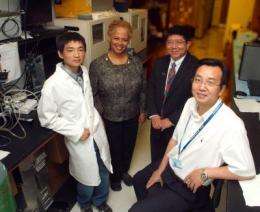Researchers identify gene linked to hereditary incontinence

Medical College of Georgia researchers have identified the culprit gene for a rare condition that turns smiles into grimaces and impedes bladder and bowel control.
Their finding provides new insight into urofacial syndrome as well as incontinence in general which affects some 20 percent of the general population.
"This paper really tells us and the scientific community is that this particular gene and its encoded proteins play a very important role in controlling facial and bladder muscle function," said Dr. Jin-Xiong She, director of the MCG Center for Biotechnology and Genomic Medicine. "From this, we hope to develop studies that will benefit not only these patients but also those with the more general problem of incontinence or overactive bladder and constipation."
Dr. She, a Georgia Research Alliance Eminent Scholar in Genomic Medicine, is a corresponding author on the study published in the American Journal of Human Genetics. The study details identification of the gene Heparanase 2 as a cause of urofacial syndrome, a genetic condition disproportionately affecting populations with common ancestry. To pass along a genetic disorder, a child must get two copies - one from each parent - of the mutated gene. Rare disorders become more common in populations where relatives marry and/or have children together.
The face, bladder and bowel all require tight control of muscle contraction. Patients with urofacial syndrome leak feces and urine, which can leak back into the kidneys and destroy them, said Dr. Bobbilynn Hawkins-Lee, a urologist at MCG, director of urodynamics and female urology at the Charlie Norwood Veterans Affairs Medical Center and study co-author.
Lack of bowel control causes constipation as well as leakage. Lack of facial control turns smiles into grimaces. "You can pick these babies out in a nursery because their facial muscles are inverted," Lee said. Older children typically give up trying to smile, opting for a more stoic look to help mask their condition.
Untreated, most children with the disease die before adulthood.
Researchers first used DNA taken from urofacial patients in Antioquia, Colombia to do genetic mapping and identify the chromosomal region containing the suspect genes. Once they narrowed the search, Dr. Junfeng Pang, a postdoctoral fellow in the lab of MCG molecular geneticist Dr. Cong-Yi Wang, completed the painstaking task of screening the 20 genes in this chromosomal region in patients from Colombia, the United States and France, until they found one gene that was mutated in every patient. Pang subsequently cloned the gene.
"We had to look for sequence errors in patients that could result in functional changes or loss of function for the encoded protein," said Wang, a co-corresponding author. "Only animals with voiding functions have this particular gene which indicates it is very important for that function." When defective, the gene produces an equally defective protein that is critical to muscle function.
While the researchers still don't know exactly what Heparanase 2 does, its mutation in urofacial syndrome patients suggests its role in muscle control related to facial expression and voiding. The scientists anticipate publishing more findings soon about the gene's function and how the mutation causes urofacial syndrome.
They also hope the research will help those with incontinence unrelated to the syndrome. Risk factors include advanced age, childbirth, pelvic surgery and spinal cord injury.
Current incontinence treatment includes behavioral therapies such as bladder training, surgery to expand capacity or bypass the bladder, intermittent catheterizations to prevent urine refluxing into the kidneys as well as drugs to prevent involuntary contraction of bladder muscles.
Lee and her husband Ron Lee, a photographer, traveled to Antioquia more than a decade ago to sketch out family trees and interview patients after learning about the genetic condition with urological implications from Dr. Bernardo Ochoa, a pediatric surgeon from the University of Antioquia in Colombia. Urofacial syndrome is also known as Ochoa Syndrome; the South American surgeon is a co-author on the new study.















